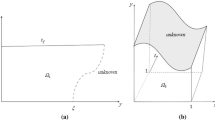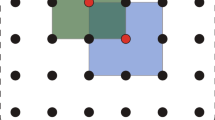Abstract
When the analysis of heat conduction is carried out by the boundary element method (BEM) under arbitrary heat generation within the domain, generally the domain integral becomes necessary. Usually the domain is divided into a number of cells for the domain integral, but by this method the merit of BEM, in which the arrangement of data is simple, is lost and several couterplans are considered. For example, the method using the particular solution, the double-reciprocity method and the multiple-reciprocity method are used[l,2]. The author propose a method using the cells of boundary type[3,4]. In the multiple-reciprocity method, the fundamental solutions of higher order are used, and infinite numbers of fundamental functions are necessary to make the solution converge. Accordingly there are some problems for the practical heat conduction analyses under steady states with internal heat generation in the domain.
Access this chapter
Tax calculation will be finalised at checkout
Purchases are for personal use only
Preview
Unable to display preview. Download preview PDF.
Similar content being viewed by others
References
A.J. Nowak and C.A. Brebbia, Advanced Formulations in Boundary Element Methods, Eds. M.H. Aliabadi and C.A. Brebbia, Chapter 3, (1993),pp.77–115, CMP.
A.J. Nowak and C.A. Brebbia, The multiple-reciprocity method. A new approach for transforming BEM domain integral to the boundary, Engineering Analysis with Boundary Elements, Vol.6, (1989), pp.164–167.
Y. Ochiai, T. Sekiya and R. Ishida, Journal of Thermal Stresses, No.17, (1994), pp.397–408.
Y. Ochiai, JSME International Journal, Series A, Vol.37, No.4, (1994), pp. 355–359.
T. Sekiya, Y. Ochiai and R. Ishida, Thermal Stress Analysis by Boundary Element Method (in Japanese), (1992), pp.17–20, Morikita.
C.A. Brebbia, J.C.F. Teils and L.C. Wrobel, Boundary Element Techniques-Theory and Applications in Engineering, Springer—Verlag, pp.47–107, (1984).
Author information
Authors and Affiliations
Editor information
Editors and Affiliations
Rights and permissions
Copyright information
© 1995 Springer-Verlag Berlin Heidelberg
About this paper
Cite this paper
Ochiai, Y. (1995). Heat Conduction Analysis by Improved Multiple- Reciprocity Boundary Element Method. In: Atluri, S.N., Yagawa, G., Cruse, T. (eds) Computational Mechanics ’95. Springer, Berlin, Heidelberg. https://doi.org/10.1007/978-3-642-79654-8_448
Download citation
DOI: https://doi.org/10.1007/978-3-642-79654-8_448
Publisher Name: Springer, Berlin, Heidelberg
Print ISBN: 978-3-642-79656-2
Online ISBN: 978-3-642-79654-8
eBook Packages: Springer Book Archive




